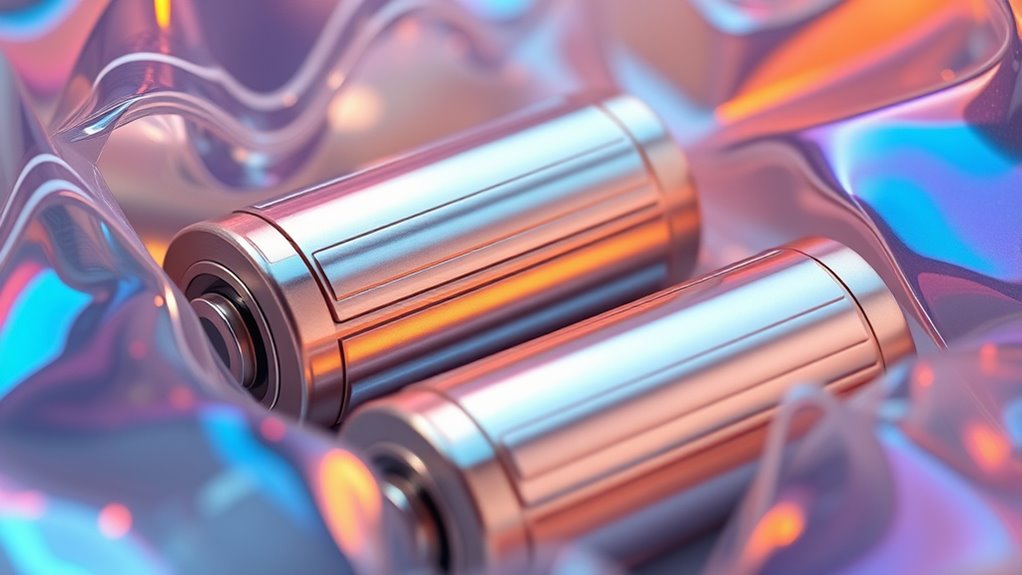Thermal batteries and phase-change materials (PCMs) help you store and manage heat efficiently. PCMs absorb and release thermal energy during melting and solidifying, maintaining stable temperatures for your systems. When combined with electrochemical storage, they create powerful hybrid solutions that improve energy efficiency and support renewable sources. If you want to discover how these materials work together to optimize thermal management and boost sustainability, keep exploring further.
Key Takeaways
- Thermal batteries store and release heat through phase-change materials (PCMs) that absorb or emit latent heat during melting and solidifying.
- PCMs enable stable temperature maintenance and large heat storage at nearly constant temperatures, ideal for thermal management applications.
- Combining thermal batteries with PCMs enhances energy efficiency by providing steady heat supply and reducing active heating or cooling needs.
- Latent heat during phase transitions allows thermal batteries to buffer thermal energy, supporting applications in HVAC, industrial processes, and aerospace.
- Integrating phase-change materials with electrochemical storage creates hybrid systems that improve renewable energy utilization and overall energy management.

Have you ever wondered how devices maintain stable temperatures or how energy storage systems work efficiently? The answer often lies in the fascinating world of thermal batteries and phase-change materials. These technologies play a vital role in managing heat and storing energy, ensuring systems run smoothly and reliably. Central to this are concepts like electrochemical storage and latent heat, which work together to optimize energy use and temperature regulation.
Electrochemical storage is a key component in many energy systems. It involves storing energy in chemical form within batteries, which can then be converted back into electrical power when needed. Thermal batteries, however, focus more on storing heat rather than electricity. They leverage phase-change materials (PCMs) that absorb and release thermal energy during melting and solidifying processes. This process is highly efficient because it allows the storage of large amounts of heat at a nearly constant temperature, making PCMs ideal for applications requiring precise temperature control. When energy is needed, the PCM releases its stored latent heat as it solidifies, providing a steady heat source for devices like HVAC systems, industrial processes, or even spacecraft.
Latent heat is the core principle behind phase-change materials. It’s the energy absorbed or released during a material’s phase transition—say, from solid to liquid or vice versa—without changing temperature. This property makes PCMs exceptional for maintaining stable temperatures over time. For example, a PCM might melt at a specific temperature, absorbing heat without increasing in temperature, therefore acting as a thermal buffer. When the surrounding environment cools, the PCM solidifies, releasing the stored latent heat and warming the space or device. This cycle of melting and solidifying allows for efficient thermal regulation, reducing the need for constant active heating or cooling. It’s like having a thermal battery that charges when excess heat is available and discharges when heat is needed.
By combining electrochemical storage with phase-change technology, engineers can develop hybrid systems that store both electrical and thermal energy, increasing overall efficiency. These systems are especially valuable in renewable energy applications, where excess energy generated can be stored as heat or electricity for later use. For instance, surplus solar or wind energy can be converted into heat stored in PCM-based thermal batteries, then released during periods of low generation. This synergy reduces energy waste and enhances sustainability.
Understanding how phase-change materials store and release energy is crucial for advancing thermal management solutions. In essence, understanding and harnessing latent heat through phase-change materials, along with electrochemical storage techniques, offers innovative solutions for energy management. They enable devices to operate more efficiently, maintain stable temperatures, and store energy effectively—advancing how we power our homes, industries, and transportation systems.
Frequently Asked Questions
How Long Can Thermal Batteries Store Energy Before Activation?
You can store energy in thermal batteries for several years before activation, thanks to their high thermal stability. They’re designed to retain energy effectively over long periods, often up to 10 years or more, without significant loss. This long-term energy retention guarantees that when needed, the battery can be activated reliably, providing quick power delivery. Proper storage conditions help maintain this stability, ensuring your thermal battery remains ready when you need it most.
What Are the Environmental Impacts of Using Phase-Change Materials?
You might not realize it, but choosing phase-change materials impacts the environment more than you think. Their environmental footprint varies, with some materials causing minimal ecological effects, while others involve toxic substances or energy-intensive production. This hidden cost can affect ecosystems, water quality, and air pollution. Being aware of these impacts helps you make more eco-conscious decisions, encouraging the development of sustainable options that minimize harm and protect our planet’s delicate balance.
Can Thermal Batteries Be Recycled or Reused?
You can often recycle or reuse thermal batteries, but it depends on their material durability and design. Battery recycling involves extracting useful materials to reduce waste and environmental impact. Some thermal batteries are built for multiple uses, allowing you to extend their lifespan, while others may require specialized recycling processes. Always check manufacturer guidelines for proper disposal or reuse options to guarantee you’re handling them responsibly.
How Do Phase-Change Materials Perform in Extreme Temperatures?
You might worry that extreme temperatures could impair phase-change materials, but they actually perform well if designed properly. Their phase transition efficiency remains high, even in harsh conditions, thanks to excellent temperature stability. This means they can absorb or release heat reliably across a wide temperature range, making them ideal for applications demanding precise thermal regulation in extreme environments. Proper formulation guarantees consistent performance, regardless of temperature extremes.
What Are the Safety Concerns Associated With Thermal Batteries?
You should be aware that thermal batteries pose safety hazards, mainly due to the risk of thermal runaway, which can cause fires or explosions if mishandled. Proper safety protocols, like temperature control and protective equipment, are essential. Handling these batteries carefully prevents hazardous situations. Always follow manufacturer guidelines and guarantee proper storage to minimize risks associated with their high temperatures and reactive materials.
Conclusion
In wrapping up, you now see how thermal batteries and phase-change materials are game-changers in energy storage, making your future more sustainable. These tech marvels, much like a modern-day alchemist, transform heat into usable power efficiently. While they’re not quite from a sci-fi novel, their potential is just as exciting. Embrace these innovations, and you’ll be steering your own DeLorean toward a greener tomorrow, proving that even in today’s age, magic still happens.










